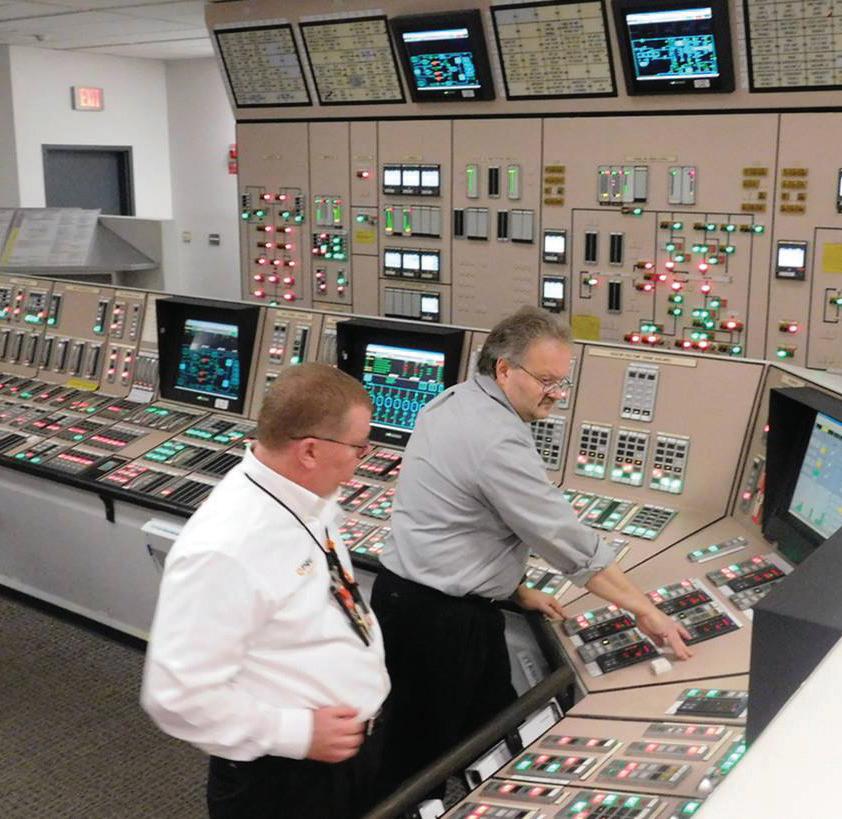
8 minute read
Thought Leaders: Opinion & Commentary
Combating Climate Change is a Fight Worth Having
By Rick Thigpen, Senior Vice President, Corporate Citizenship, PSEG
Advertisement
New Jersey is familiar with being on the front lines of environmental challenges. It’s no coincidence that we were one of the first states to create a cabinet-level Department of Environmental Protection. We are also the state that gave birth to the federal Superfund law, drafted by then-U.S. Rep. Jim Florio to deal with the cleanup of hazardous substances released into the environment. Our newest challenge, and perhaps the toughest yet, is climate change.
We’re growing increasingly familiar with the stronger, more extreme weather that is being caused by our planet’s changing climate. As noted by C2ES, Yale University and others, hurricanes will grow far more costly without action. As a coastal state with a highly-developed shoreline, New Jersey is extremely vulnerable to potential damages caused by rising sea levels.
Rather than sit on our hands, we need to answer the call: reduce our carbon footprint or face the consequences. On behalf of our children, this is a fight worth having.
Thankfully, in New Jersey, we already get nearly 40% of our electricity from a carbon-free source: nuclear energy. Nuclear provides more than 90% of the carbon-free power generated in New Jersey, making it a critical pillar in the state’s clean energy ambitions.

Despite the many benefits nuclear energy provides, its continued service in New Jersey is not guaranteed. As long as policymakers in Washington continue to refuse to recognize the costs of carbon when setting wholesale electric market prices and oppose state support for carbon-free generation, fossil fuels will be the lowest-cost option to generate electricity. Nothing would jeopardize New Jersey’s clean energy future more than standing by while productive nuclear plants shut down for lack of policy support.
Three years ago, New Jersey lawmakers took action to prevent nuclear plants serving the state from retiring prematurely due to insufficient revenues from energy markets. This Zero Emissions Certificate (ZEC) law, which requires applicants to submit detailed financial data to the BPU to demonstrate the need for financial support, is the reason New Jersey continues to enjoy the benefits of nuclear power. Our critics have argued this law amounts to a subsidy of PSEG’s nuclear plants. And PSEG’s plants do benefit from this support. Have no doubt, without this law, Washington policies favoring fossil fuels would have forced them to close.
If anything, market conditions for nuclear plants have only gotten worse since the first ZEC process played out – meaning that, at a minimum, New Jersey’s nuclear fleet will need the same level of continued ZEC support in order to remain viable.
Today, the need to generate as much carbon-free electricity as possible has only grown more urgent. Soon, New Jersey will decide whether to continue to provide support for these nuclear plants, which generate enough electricity to power 3.8 million homes and also help avoid 14 million tons of carbon emissions every year – the equivalent of taking 3 million cars off the road. Never forget, it is cheaper for ratepayers to keep these plants open than it is to close them.
We know what happens when nuclear plants close. Oyster Creek was New Jersey’s smallest nuclear plant when it shut down permanently in October 2018. During the following year, more than two-thirds of the electricity generated to replace Oyster Creek’s production came from the increased use of New Jersey’s natural gas-burning power plants. The rest was supplied by out-of-state coal and natural gas. The result was an additional 3.1 million tons of carbon released into the air.
By contrast, New Jersey’s 3,500-megawatt Salem and Hope Creek nuclear plants are five times larger than Oyster Creek – which would magnify the carbon emissions impact if they were to close.
At PSEG, we’re committed to supporting our state and doing what is in the best interests of our customers and communities. Working together, we can ensure the state is able to produce the electricity we need to power our homes and businesses without producing the carbon emissions we don’t. To accomplish that, we need to renew New Jersey’s ZEC program at its current level of economic support.
If you believe that climate change is not only a global challenge, but also one that hits New Jersey particularly hard, then the battle to preserve New Jersey’s nuclear plants is one we can’t afford to lose.
Today, our shared priority is to preserve nuclear energy as an important part of New Jersey’s clean energy mix. To fight climate change, we’ll need as much carbon-free energy as we can make and to reduce our overall energy usage. Preserving New Jersey’s clean energy agenda at the lowest possible cost is worth fighting for. Rick Thigpen is PSEG’s senior vice president for Corporate Citizenship and chairman of the PSEG Foundation.


This ‘Terminal’ is Just the Beginning

The economies of New Jersey and New York were connected long before there even was a United States. But it would take centuries before the political will and technological advances would literally connect the people of North Jersey to the metropolis to its east.
The Port Authority of New York and New Jersey has been a key player in that figurative and literal bridge building for 100 years. The infrastructure that connects two great states – and transformed North Jersey into a global economic powerhouse, a major sports-entertainment destination and an incomparable place to raise families – was either built by or improved by the Port Authority.
In recent years, the Port Authority committed to rebuilding its three major airports. Notable progress on this ambitious goal is visible at Newark Liberty International, where a new terminal and a new car rental facility is taking shape, and at LaGuardia, where the once-vilified airport has become a stunning example of how the Port Authority can deliver massive complicated projects on time.
But there was one significant facility left out; a facility that – despite more than $100 million in recent quality-of-life improvements – is not delivering 21st century service to commuters. That is not surprising because it is a symbol not of this century, but of the previous one. I am, of course, referring to the Midtown Bus Terminal.
Labeled by comedian John Oliver as “the single worst place on Planet Earth,” the bus terminal, which opened in 1950, is outdated and insufficient in size to meet the needs of today.
I am happy to state the infamous bus terminal’s days are numbered.
In January, the Port Authority announced it had settled on a single, transformative plan for a new Midtown Bus Terminal. This is momentous.
Political leaders and community stakeholders agree this is the right plan. This is extraordinary.
The plan, the vision and the timing are


all aligned. And this is in great part because of Senate Majority Leader Loretta Weinberg, D-Teaneck.
Senator Weinberg advocated for a new bus terminal even when few would listen. She has tirelessly focused on ensuring that the 260,000 New Jersey passengers who move through the bus terminal on a typical day will literally move through the bus terminal quickly, efficiently through modern concourses, and in commuter buses that will better navigate the terminal and surrounding streets. • New Jersey commuters need a bus terminal designed for current and future capacity. • Bus operators need a terminal designed to handle growing volume, facilitate the swift turnaround of buses inside the terminal, and that can accommodate future all-electric fleets with a 21st century charging structure. • Local residents need a terminal that is part of their community, designed to welcome not only commuters and shoppers, but also the people who live around the facility with street-side storefronts and new public green space.
The plan unveiled by the Port Authority in January addresses these needs.
The new Midtown Bus Terminal will be built on its existing footprint, providing for a nearly 40% increase in capacity, removing congestion from local streets with the addition of a storage and staging facility, and because it will be built on the terminal’s existing footprint, will still offer commuters easy connections to 12 subway lines.
The terminal will expand west on Port Authority-owned property to include a facility for bus staging and for inter-city buses, with new ramps to the terminal. Supporting the Port Authority’s commitment to the tenets of the Paris Climate Agreement, the facility will also have a charging structure to support future all-electric fleets and create 3.5 acres of new green space in the surrounding neighborhood.
Multiple community meetings were held to listen to residents, businesses, public leaders and other stakeholders – many of whom pointed out the importance of getting idling buses and their emissions off local streets. Their combined input resulted in a better proposal – one that will yield a bus terminal that will both grow with and respect the community it serves.
As our region remains in the grips of a oncein-a-hundred-year pandemic, it may be hard to visualize life returning to the way it was before the coronavirus. History informs our present and guides us into the future.
In the years following the influenza pandemic of 1918, the nation did not go backwards, but forward. It “roared” into the next decade. And the Port Authority, created on April 30, 1921, was there at that transformational moment.
I cannot predict the future, but I know New Jerseyans.
We move forward. We innovate. We create the technologies of tomorrow today.
That unique Jersey spirit will drive a regional economic recovery. And when it comes to understanding “driving,” the Port Authority has and will take the lead.
We will build a new Midtown Bus Terminal to serve the needs of a region on the move. The Port Authority did it in 1950. It will do now. This new world-class, 21st facility may still be called a terminal, but it will be the beginning of something new. Kevin J. O’Toole is the Chairman of the Port Authority of New York and New Jersey.
The opinions expressed in this section are those of the submitting authors and do not necessarily represent the views of and may not be attributed as opinions of the Meadowlands Chamber or Meadowlands Media.









